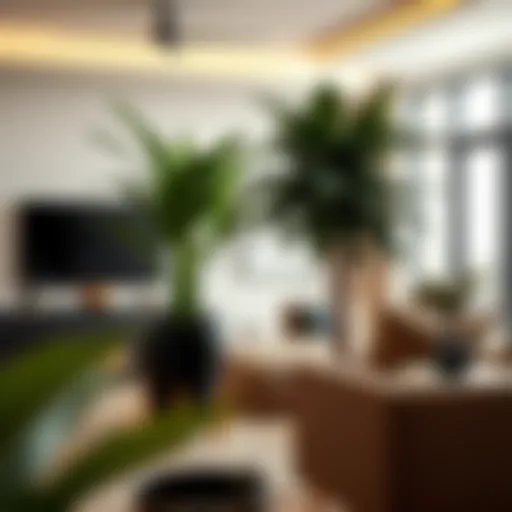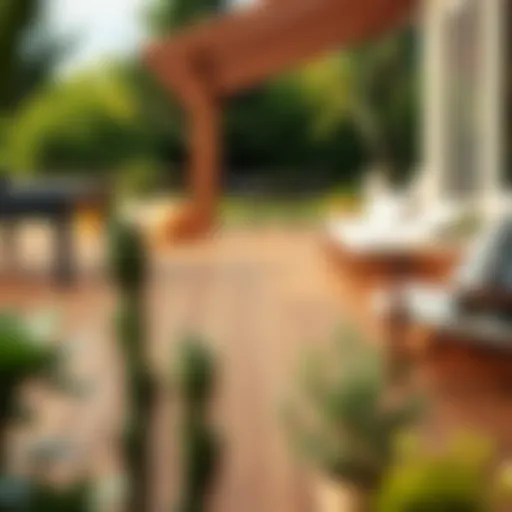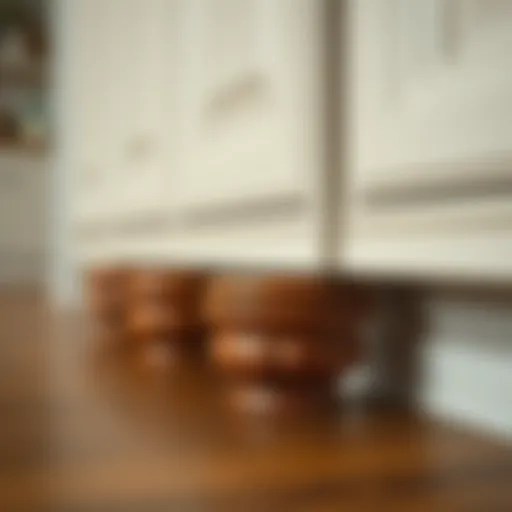Comprehensive Guide to Interior Blinds for Modern Homes
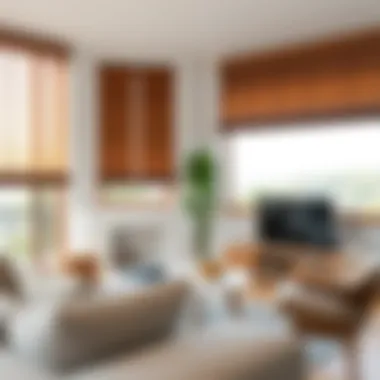
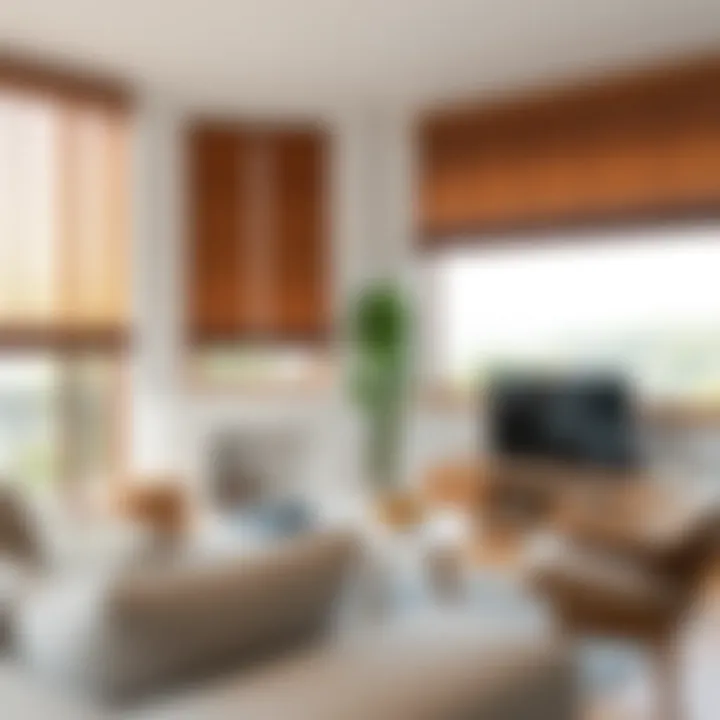
Intro
Interior blinds have become a mainstay in contemporary homes, transcending their basic functional role to contribute significantly to interior design. Homeowners, designers, and DIY enthusiasts alike are increasingly recognizing how these versatile fixtures enhance aesthetics while serving practical purposes. Whether you're looking to control sunlight, enhance privacy, or simply elevate your space's decor, understanding the variety of options available is crucial. This guide aims to shed light on the multifaceted world of interior blinds, from the latest trends to materials and installation tips, ensuring that you can make informed choices tailored to your unique style and needs.
Furniture Design Trends
Current Styles and Aesthetics
When it comes to interior blinds, it's not just about functionality anymore. They play an aesthetic role, blending seamlessly with furniture design trends. Popular styles range from sleek modern rollers to traditional wooden Venetian blinds.
- Modern Minimalism: Clean lines and simple designs characterize this trend. Blinds that align with this style often come in muted colors, allowing for a more understated elegance.
- Vintage Vibes: On the other end, you’ve got blinds that channel nostalgia, like classic Roman shades that drape elegantly, infusing a touch of warmth into rooms.
- Eclectic Mix: Homeowners now often mix and match, bringing together blinds of different materials and styles for a personalized touch. Think a bamboo shade paired with metal frame windows.
Color Palettes and Materials
The choice of color and material can make a vast difference in how blinds fit into a room's overall feel. Here are a few dominating materials and color trends:
- Natural Materials: People are leaning towards organic textures, from bamboo to linen. They add warmth and a tactile quality to spaces.
- Bold Colors: Gone are the days of bland whites and browns. Homeowners are embracing rich hues like deep blues, emerald greens, and even fiery reds to make statements.
- Sustainable Choices: Materials that are eco-friendly are on the rise. Products made from recycled or responsibly sourced materials can appeal to the environmentally conscious, offering both style and substance.
Buying Guides
Essential Considerations When Purchasing
Before diving into buying blinds, consider these factors:
- Window Size and Shape: Measure your windows carefully. Custom blinds may be necessary for uniquely shaped or oversized windows.
- Light Control Needs: Decide how much light you want in your space. Some blinds offer blackout features, ideal for bedrooms, while sheer options may be better for living areas.
- Safety Features: For homes with pets and children, safety is key. Look for blinds with cordless options or those that comply with safety regulations.
Top Recommendations for Different Budgets
Finding the right blinds doesn't have to break the bank. Here are some suggestions across different budget ranges:
- Budget-Friendly: Brands like IKEA offer stylish options at an affordable price point, making it easier to find something that fits without skimping on style.
- Mid-Range Choices: Hunter Douglas blinds provide an array of designs and quality build for those willing to invest a bit more.
- High-End Selections: For those seeking luxury, Lutron offers premium options integrated with smart home technology, maximizing both style and convenience.
Choosing the right interior blinds can significantly impact the ambiance of a space while reflecting personal style. Analyze your practical requirements along with your aesthetic choices to find the right balance.
By understanding current trends and being guided by thoughtful buying strategies, you can transform a simple window treatment into a focal feature that amplifies your interior design.
Understanding Interior Blinds
Interior blinds are not just mere window coverings. They harmonize function with aesthetics, offering homeowners a way to enhance their spaces while addressing practical needs. As such, understanding blinds is critical for anyone looking to invest in their living or working environment.
Definition and Purpose
So, what exactly are interior blinds? They’re essentially functional fabric or material coverings designed to control light, privacy, and temperature. Blinds come in various materials, styles, and operation mechanisms, each tailored to suit different preferences and functional requirements. In simpler terms, they act as a barrier between your cozy home and the outside world.
Their purpose goes beyond just blocking sunlight. They can help maintain indoor temperature by insulating windows and controlling glare, which makes them not only a stylish addition to a room but also a practical one. Homeowners can easily adjust them throughout the day as the sun shifts, granting them control over the ambiance of their living spaces. In a way, interior blinds are akin to a canvas that can be painted with light and shadow.
Historical Context
The history of interior blinds is quite interesting. The inception of window blinds makes for a fascinating timeline, reflecting changes in societal needs and aesthetics. The ancient Egyptians were perhaps the first to utilize simple shades made from woven reeds or textiles to shield their interiors from the blazing sun. As time meandered along, this concept made its way across continents and evolved into various forms.
By the late Middle Ages, wooden shutters emerged in Europe, giving people a different yet essential option for light control and privacy. Fast forward to the 18th century, and the introduction of Venetian blinds revolutionized the market. With slats that could be tilted, they provided a fresh level of light modulation while preserving privacy.
As industries advanced, so did the materials used for blinds, leading to a rich variety today—from aluminum to sustainable bamboo finishes. Each type bears the marks of its era's technological and aesthetic aspirations. In today’s world, with a growing focus on sustainability and smart technology, window treatments are developing at a remarkable pace, reflecting our evolving relationship with our homes.
In summary, understanding the various facets of interior blinds enriches one's perspective on design and functionality. The thoughtful integration of blinds can significantly elevate the ambiance and utility of any space.
Types of Interior Blinds
When it comes to enhancing the ambiance of a space, types of interior blinds play a significant role. Their impact isn’t just about looks; each type has unique qualities that serve specific needs.
Venetian Blinds
Material Options
Venetian blinds are often made from a variety of materials, including wood, aluminum, and PVC. Aluminum is a popular choice due to its lightweight nature and resistance to moisture. On the other hand, wood lends a natural charm, giving warmth to the room.
A key characteristic of Venetian blinds is their horizontal slats, which can be adjusted to control light while maintaining privacy. Many homeowners favor wood for its luxurious appearance, though it typically requires more maintenance compared to synthetic materials. The slats can be found in various colors and finishes, an advantage that makes it easy to harmonize with other design elements in your home. However, wood blinds can warp in humid environments, which is a downside to consider.
Functional Benefits
Ventian blinds are known for their versatility in light control. They allow you to tilt the slats to achieve the desired amount of natural light filtering through. This feature is especially beneficial in sunny rooms where glare can be a nuisance.
Moreover, they provide a level of privacy that can be adjusted according to your needs. The ease of cleaning is another compelling reason for their popularity – a simple wipe down is often enough to keep them looking sharp. Yet, it’s worth mentioning that the cords that control the tilt can become tangled if not managed properly, which could detract from their appeal.
Roman Blinds
Fabric Choices
When exploring fabric options for Roman blinds, you’ll encounter a range of materials, from cotton to luxurious silks. Choosing the right fabric is crucial as it affects not only aesthetic quality but also functionality. For instance, cotton offers breathability and easy maintenance, making it suitable for a variety of spaces, while silk adds elegance and sophistication.
A significant aspect of fabric choices is the pleating type—flat, hobbled, or relaxed styles can tailor the overall feel of a room. Each fabric also comes with a unique texture, impacting how they interact with light. The drawback, however, lies in the fabric's susceptibility to fading under direct sunlight, unless treated to resist UV rays.
Style Variations
Roman blinds come in various styles, such as flat or traditional pleat. Flat Roman blinds provide a clean, minimalist look when fully lowered, while hobbled styles create a softer, more relaxed appearance. This variety allows for adaptability to different decor themes, from casual to formal.
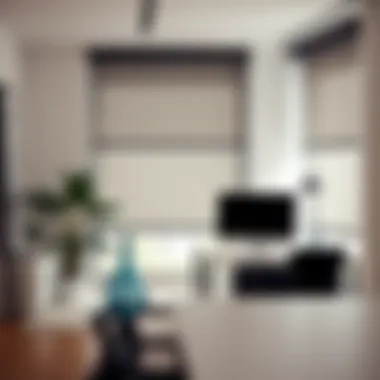

They can also be customized with patterns and colors, providing an opportunity for personal expression that fits the homeowner’s style. However, one thing to consider is their bulk when drawn up, which can take away from the view or space if not designed thoughtfully.
Roller Blinds
Design Simplicity
Roller blinds represent an epitome of design simplicity. This straightforward style allows them to fit a range of windows without overwhelming the room. The minimalistic design means there’s usually less hardware involved, which tends to blend seamlessly with modern decor.
Their clean lines provide a sophisticated look, making them a favorable choice for those looking for unobtrusive window treatments. However, the simplicity can be a double-edged sword; while they are aesthetically pleasing, they may lack the character that other, more elaborate blinds offer.
Customization Options
Roller blinds offer a plethora of customization options such as fabric selection, color choices, and even the degree of opacity. Some fabrics allow light filtering while others provide blackout capabilities, catering to specific needs in different rooms. This adaptability makes them suitable for bedrooms, living rooms, or home offices.
That said, while they can look sleek and modern, they might not satisfy those who seek ornamental features. People who enjoy intricate designs might find this type a bit too plain for their taste.
Vertical Blinds
Ideal Settings
Vertical blinds excel in large spaces, such as sliding doors or expansive windows, offering an effective solution that maximizes light control. Their vertical orientation allows them to cover wide areas, while still enabling you to adjust the slats.
These blinds are particularly suited for spaces that demand functionality, such as offices and commercial settings. One aspect of this type is their ability to provide ample privacy with ease of operation. Yet, they might flutter or sway with air movement, which could detract from their elegance.
Light Control
With vertical blinds, adjusting slats vertically creates versatility in light management. The sheer nature of some materials can soften sunlight while providing privacy, making them ideal for differing setups.
One distinguishing feature of vertical blinds is their straight lines that can alleviate the cluttered look sometimes found with other types. On the flip side, aligning and keeping the blinds straight can be a bit of challenge, particularly if they are used frequently.
Pleated Blinds
Insulation Properties
Pleated blinds are noteworthy for their insulation properties. This design traps air within its honeycomb structure, providing a buffer against outside temperatures. As such, they can keep a home cooler in the summer and warmer during winter months, which can lead to energy savings.
Another key characteristic of these blinds is that they are lightweight yet durable. They often come in various fabric choices that are not only functional but also visually appealing. However, regular cleaning is necessary to maintain their performance, as dust can collect in the pleats over time.
Aesthetic Appeal
Aesthetically, pleated blinds offer a unique texture that can add dimension to a room’s decor. They can be found in numerous colors and prints, allowing homeowners to choose a style that harmonizes with their interiors.
Yet, the intricate design can sometimes restrict some light when placed in smaller windows, presenting a design challenge in terms of visibility. Finding the right balance can turn them into a stunning focal point.
Cellular Shades
Energy Efficiency
Cellular shades boast exceptional energy efficiency thanks to their innovative design that creates an air pocket between the window and the room. This barrier reduces heat transfer and can lead to significant energy savings.
In terms of regulating temperature, this feature becomes a noteworthy advantage. They help maintain a stable environment within your home while minimizing reliance on heating and cooling systems. However, the initial cost can be higher than other blinds, which might hinder broader acceptance.
Design Options
Beyond functionality, cellular shades offer a vast array of design options that cater to different home aesthetics. Available in various colors, textures, and opacity levels, they can adapt to various styles, from contemporary to traditional.
One of the unique aspects of these shades is their ability to fit into virtually any window, even odd-shaped ones. While they tend to be a bit pricier, the combination of energy efficiency and design versatility makes them a worth investment for many homeowners.
Material Considerations for Blinds
When laying the groundwork for selecting interior blinds, understanding the material used in their crafting plays an instrumental role. The materials not only dictate the aesthetic appeal but also impact functionality, durability, and maintenance. Each choice comes with its own set of advantages and potential drawbacks, reflecting various preferences and needs of homeowners, designers, and DIY enthusiasts. Let's explore the multitude of options.
Wooden Blinds
Natural Aesthetics
Wooden blinds boast a warm and inviting look that can effortlessly elevate any living space. Their natural aesthetics not only add a touch of elegance but also offer a timeless quality that synthetic options often struggle to replicate. The rich grains and earthy colors can create a sense of coziness and sophistication, making them a popular choice for those looking to enhance their interior design. However, it's important to consider that while they are visually pleasing, they may require more careful handling to prevent warping or cracking over time.
Durability
One of the standout attributes of wooden blinds is their long-lasting durability. While they come with an initial investment, the return in terms of lifespan might surpass that of other materials. Quality wood has resilience against everyday wear and tear. However, exposure to moisture can affect their integrity, making them less suitable for humid areas such as bathrooms or kitchens. Careful placement, then, becomes crucial to maximizing their lifespan.
Synthetic Materials
Affordability
When budget constraints come into play, synthetic materials are often the knight in shining armor. Their affordability makes them accessible to a wide range of consumers, enabling homeowners to achieve a stylish look without breaking the bank. Despite being cost-effective, many synthetic options offer a decent mimicking of wood or fabric textures, which can be quite attractive. But keep in mind, while they are budget-friendly, their lifespan may not match that of wooden varieties, which could lead to future replacements.
Maintenance
Synthetic blinds are also noted for their low-maintenance requirement. Unlike wood that may need periodic polishing and careful cleaning, synthetic materials are generally easier to care for. Most can simply be wiped down with a damp cloth, making it easy to keep them looking fresh. That said, they might lack the unique character and depth that natural materials present, potentially leaving some buyers wanting more in terms of aesthetics.
Fabric Blinds
Texture and Feel
A significant characteristic of fabric blinds is their tactile element—the texture and feel can greatly enhance the sensory experience within a room. Ranging from soft to woven options, fabric can add layers of comfort and richness to interiors. Their variety can cater to almost any design theme, from bohemian to contemporary. However, fabric choices can be affected by dust and stains more readily than other materials, possibly requiring specialized cleaning methods, which might deter some homeowners.
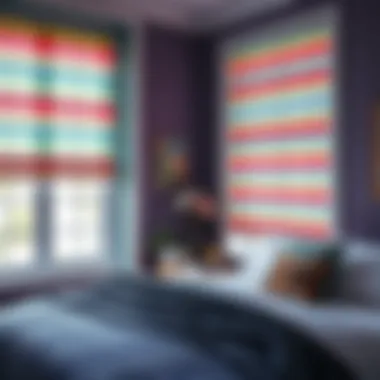
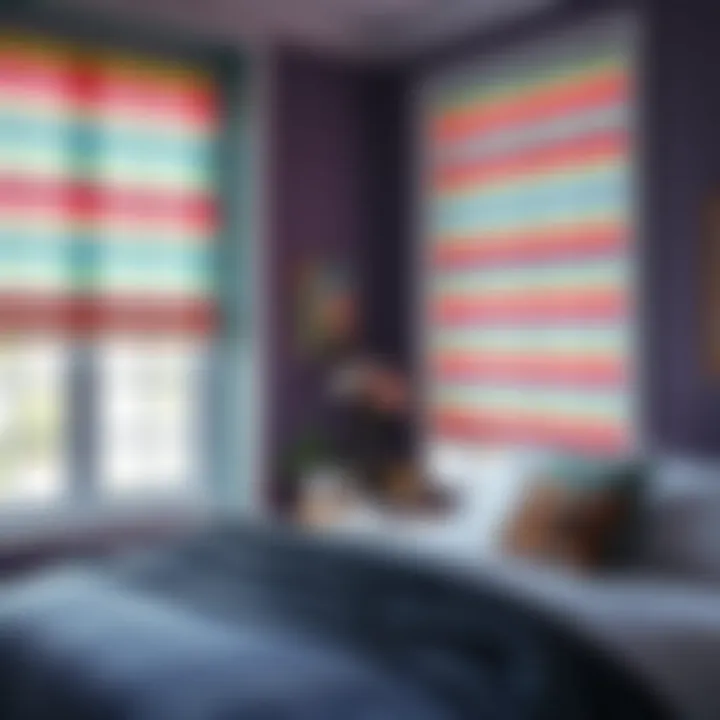
Color Options
In terms of color options, fabric blinds are practically unrivaled. From muted tones to bold patterns, the choices available can match any color palette. This versatility makes them a favored option among those who want to make a statement without undergoing a complete revamp of their spaces. That said, colors may fade over time, especially when exposed to direct sunlight, which is something to keep in mind when making your selection.
The key to selecting the right blinds is balancing aesthetic appeal with practical considerations, ensuring you choose a material that fits both your style and your lifestyle.
Functional Benefits of Interior Blinds
Interior blinds serve more purposes than just looking nice. They are functional products that have real-world benefits in home environments. Understanding these benefits lays the foundation for making smart decisions about which blinds to choose. Here, we’ll dive into the three key areas: light control, privacy enhancement, and energy efficiency.
Light Control
One of the primary functions of interior blinds is to provide light control. Imagine you’re in a room bathed in sunlight, wanting to relax but facing glare from the bright rays hitting your screen. With the right blinds, this problem can be deftly managed.
Blinds like Venetian ones allow you to adjust the angle of the slats, enabling you to direct natural light exactly where you want it. Pull them up for bright openness or lower them to block out unwanted brightness. Similarly, blackout options for roller blinds offer complete light elimination, making those afternoon naps feel luxurious. For example, if you're working on a creative project and need focused lighting, angled blinds can filter light efficiently without creating harsh shadows.
Here’s a quick breakdown of key light control features:
- Adjustable slats for tailored light patterns
- Blackout fabrics for total darkness when necessary
- Translucent options for a soft glow while maintaining some privacy
Privacy Enhancement
Privacy is not just a luxury; it's a necessity. Interior blinds create a barrier that keeps your personal life safe from prying eyes. Consider this scenario: you’re living in a bustling neighborhood, and each window seems like a stage for passersby. Having the right blinds can provide instant relief.
For instance, Roman blinds can be drawn up for a scenic view while ensuring obscurity when lowered. Vertical blinds in a sliding door section can serve double duty, allowing you to direct views while blocking ones you don’t want. The beauty is in the flexibility that blinds can offer—tailored to your lifestyle needs.
Some key points to remember about privacy:
- Blinds can be opened partially to allow light while still protecting your space
- Layering sheer fabrics with heavier ones enhances both softness and seclusion
- Certain materials can obscure visibility from outside while maintaining your view inside
Energy Efficiency
With the rising cost of energy, every homeowner is seeking ways to cut down bills. Believe it or not, interior blinds play a substantial role in energy efficiency. Blinds can provide an additional layer of insulation between your home and the outside elements.
Cellular shades, for instance, are uniquely designed to trap air at the window level, thus improving thermal performance. This means staying cooler in the summer and warmer in the winter. If you're considering a renovation or thinking about new purchases, these options could be game-changing regarding utility savings.
Here are a few energy efficiency highlights:
- Double-cell options for maximum insulation
- Light-colored fabrics reflecting heat away in warmer months
- Seasonal adjustments can help maintain comfort levels without overusing heating or cooling systems
Ultimately, the functional benefits of interior blinds stretch beyond mere aesthetics. They blend practical needs with personal preferences, enhancing both comfort and the atmosphere of any space. Choosing the right type can make your home a refuge, tailored to your lifestyle.
Aesthetic Contributions
The aesthetic contributions of interior blinds are pivotal in transforming a space from bland to brilliant. They are much more than mere window coverings; they serve as essential design elements that harmonize with the decor and style of the room. Not only do they impact the visual appeal, but they also play an integral role in creating a cohesive atmosphere. Understanding how to effectively choose and integrate blinds can elevate the overall design scheme of your home.
Color and Pattern Selection
Choosing the right color and pattern for your blinds can dramatically influence the ambiance of a room. Lighter shades tend to open up a space, reflecting more light and creating an airy feel. For instance, soft whites or pastels can provide a serene backdrop, allowing other design elements to shine. Conversely, darker colors like navy or charcoal can induce a sense of intimacy and warmth, perfect for spaces meant for relaxation.
When it comes to patterns, consider how they contribute to the room's character. Stripes may lend a nautical vibe, while florals can enhance a quaint, country-style aesthetic. Mixing patterns, while tricky, can yield bold, contemporary looks. Just be cautious not to overdo it; a patterned blind should effectively complement, rather than compete with, the room's other design features. Experimenting with textured materials, like woven wood or linen, can also add depth to your interiors, making the space more visually appealing.
"The right color and pattern can turn functional blinds into artful expressions of personal style."
Integration with Interior Design
For interior designers and homeowners alike, integrating blinds into an already established scheme requires consideration and forethought. Each room tells a story, and the blinds chosen should align with that narrative. For example, modern minimalistic spaces typically benefit from sleek, roller blinds in neutral tones, providing functionality without overwhelming the scheme.
On the other hand, in a rustic setting with wooden furniture and earthy tones, wooden or bamboo blinds can seamlessly tie the narrative together. It’s essential to consider the materials and finishes of existing furniture and fixtures to create a harmonious flow.
To ensure cohesive integration, take into account:
- Texture matching: Soft, lightweight fabric blinds work well in airy spaces, while heavier materials can ground a room.
- Style consistency: For instance, a classic interior might lean towards Roman blinds, while a contemporary setting could favor vertical blinds.
- Layering: Layering curtains over blinds can introduce an extra dimension to your decor, adding richness and complexity.
Installation Techniques
When it comes to transforming a space, the right installation techniques of interior blinds can make a difference between a seamless look and a haphazard finish. Understanding these techniques not only enhances the aesthetic appeal but can also improve functional aspects like light control and privacy. Whether you're a seasoned DIY enthusiast or someone considering hiring a professional, knowing how to install blinds correctly is fundamental to achieving the end result you desire.
Professional vs. DIY Installation
The decision between professional installation and DIY largely depends on your skill level, budget, and the complexity of the blinds being installed. Many homeowners find the idea of installing blinds themselves alluring due to potential cost savings.
However, opting for a professional might prove to be advantageous in some scenarios. Professionals often have extensive experience and the tools needed to tackle tricky spaces or unusual window shapes. Their expertise can also ensure that the blinds are hung correctly, which can prolong their lifespan and enhance their functionality.
On the other hand, DIY installation can offer several perks:
- Cost Efficiency: Save money on labor costs.
- Personal Satisfaction: There’s a certain pride in completing a task yourself.
- Flexible Schedule: Work on it when it suits you best.
Regardless of the route you choose, it’s essential to weigh these factors to determine what best fits your needs.
Tools Required
Equipping yourself with the right tools can make the installation process smoother and more efficient. Here’s a handy list to guide you:
- Measuring Tape: For accurate measurements of your windows.
- Level: To ensure your blinds hang straight.
- Power Drill or Screwdriver: For affixing brackets to the wall.
- Ladder: If you're working on tall windows.
- Clamps: Useful for holding blinds in place during installation.
- Pencil: Mark where your brackets will go.
Having these tools on hand can really streamline the process, whether you're taking the DIY plunge or working alongside a professional.
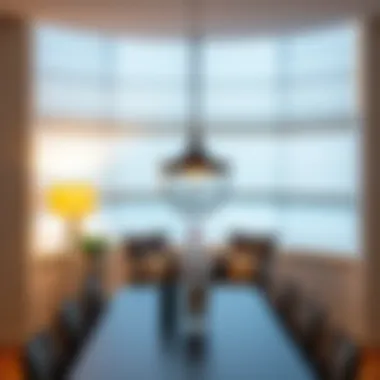
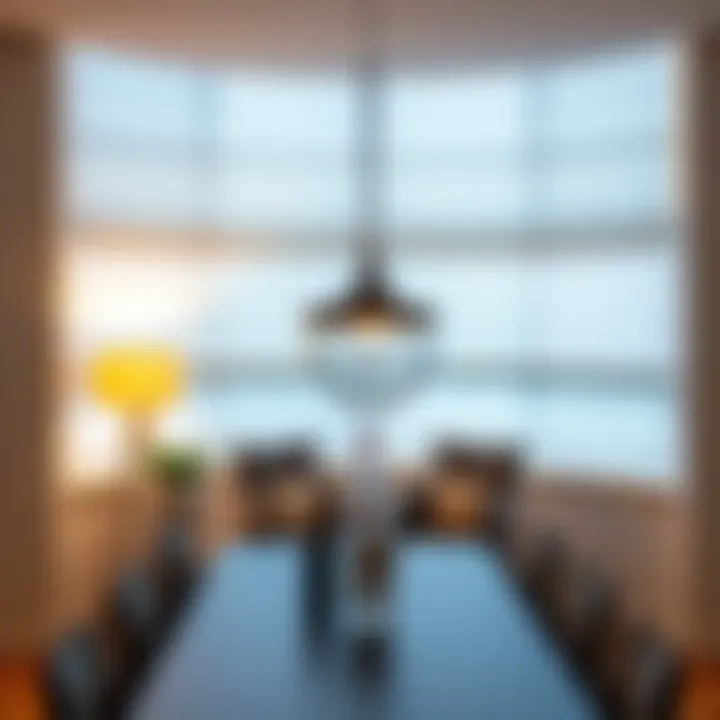
Step-by-Step Installation Guide
Installing blinds may seem daunting at first glance, but breaking down the process into manageable steps can make it much easier. Below is a straightforward guide:
- Measure Your Windows: Accuracy is pivotal. Measure the width and height and account for the type of blinds you’re installing.
- Gather Materials: Ensure all tools are ready and the blinds are unpacked. Check that you have all the components from your purchase.
- Prepare Your Space: Clear the area around the window. Lay down a cloth to catch any debris.
- Mark Bracket Placement: Use a pencil and level to mark where the brackets will go. Make sure they are even.
- Drill Pilot Holes: If you’re installing into drywall, pre-drill holes for the screws to prevent cracking.
- Secure Brackets: Use your power drill or screwdriver to attach the brackets firmly.
- Hang the Blinds: Once brackets are in place, slot the blinds into the brackets according to the manufacturer’s instructions.
- Test Functionality: After installation, raise and lower the blinds a few times to ensure they’re properly functioning.
"Following proper installation techniques not only enhances the visual appeal of your space but also prolongs the life of your blinds."
Finally, remember to regularly check the hardware and operate the blinds gently to maintain their condition over time. Taking the time to ensure a proper installation can pay dividends in functionality and appearance down the line.
Maintenance of Interior Blinds
Keeping interior blinds in good condition is crucial not just for aesthetics, but also for their functionality and longevity. Regular maintenance can greatly extend the life of your blinds while preserving their appearance. After all, a clean and well-maintained set of blinds can serve as a focal point in a room, enhancing the overall decor.
There are several key elements to consider when discussing the maintenance of interior blinds. First off, cleanliness plays a significant role. Dust and grime build-up can affect not just the look but also the mechanical functionality of the blinds. Additionally, proper handling during maintenance tasks can prevent accidental damage. Lastly, knowing the specific materials of your blinds allows for tailored care methods that can ensure their longevity.
Cleaning Methods
The way in which you clean your blinds can vary based on their type. Here are a few methods tailored for different materials:
- Vinyl and Faux Wood Blinds: These are typically very easy to maintain. A damp cloth or sponge with mild soap can do wonders. Ensure to dry them afterward to avoid any water spots.
- Wood Blinds: Wood requires a little more care. Using a soft, dry cloth will suffice, but for deeper cleaning, a mix of vinegar and water can be effective. Avoid soaking them to maintain the wood's integrity.
- Fabric Blinds: For Roman or roller blinds made from fabric, a vacuum with a brush attachment can help. Spot-clean any stains with a fabric-safe cleaner, but always refer to the care label first for specific instructions.
“A little maintenance saves a lot of headaches later.”
Consistency is key, and checking your blinds regularly can prevent the dirt build-up from becoming overwhelming. A monthly dust-off can keep them looking fresh.
Longevity Tips
Maintaining the functionality and appearance of your blinds goes beyond just cleaning. Here are a few tips to ensure their longevity:
- Regular Inspections: Check for any signs of wear and tear regularly. Early detection of issues like fraying cords or bent slats can prevent bigger problems down the line.
- Correct Operation: Avoid forcing the blinds up or down. If they seem stuck, find the source rather than exerting excessive force, which could damage the mechanism.
- Sunlight Protection: Direct sunlight can cause materials, especially fabrics and wooden blinds, to fade or warp over time. Where possible, try to use UV-protectant films or shades to keep your blinds looking new longer.
- Storage Considerations: If you need to take your blinds down for cleaning or seasonal changes, store them in a dry, cool place, preferably in their original packaging. This can prevent dust accumulation and other potential damage.
Taking the time to properly maintain your interior blinds can make all the difference. Not only will it enhance their functionality, but with a little effort, they can continue to complement your home’s aesthetic for years to come.
Current Trends in Interior Blinds
As the world increasingly embraces sustainability and technology, interior blinds are not just functional fixtures anymore, they have evolved into integral parts of modern design. Homeowners, designers, and DIY enthusiasts are now more aware of how these elements can influence the overall ambiance of a space. Incorporating current trends in interior blinds can elevate the aesthetic appeal and practicality of a room while aligning with contemporary values such as environmental responsibility and smart living.
Sustainable Options
The rise of eco-consciousness among consumers has led to significant interest in sustainable blind options. From organic materials to recyclable products, the trend is steering many towards greener choices. Bamboo blinds, for example, not only provide a unique aesthetic but are also made from a renewable resource. They are lightweight and effective at filtering sunlight, making them both beautiful and functional.
Another increasingly popular choice includes recycled fabric blinds. These are made from fibers that would otherwise end up in landfills. The ability to select from a variety of styles, colors, and textures adds to their appeal, allowing homeowners to make environmentally friendly choices without compromising on style.
Key benefits of sustainable options include:
- Reduced Environmental Impact: Choosing materials that are renewable or recycled helps decrease overall waste.
- Improved Indoor Air Quality: Non-toxic, natural materials in blinds mean healthier spaces free from harmful chemical emissions.
- Long-term Cost Savings: While the initial investment might be higher, the durability of high-quality, sustainable blinds often pays off in the long run.
"Investing in sustainable blinds not only beautifies your space but also gives back to the environment."
Smart Blinds
With technology reshaping our lifestyles, smart blinds are becoming a key element in modern homes. These are motorized blinds that can be controlled via smartphone apps or smart home systems. Imagine waking up in the morning and your blinds automatically opening to let in the sunshine, or setting them to lower at a certain time for privacy; that's the kind of convenience smart blinds can offer.
Benefits of integrating smart blinds into your home include:
- Energy Efficiency: Smart blinds can adjust according to the time of day, season, or even sunlight intensity, optimizing natural light and maintaining temperature.
- Convenience and Comfort: No need to get up or move to adjust your blinds; it can all be done with a tap on your smartphone or voice commands.
- Enhanced Security: By using an app to schedule when blinds open or close, you can give the impression of being home even when you're away, providing an extra layer of security.
As you consider options for your space, keep an eye on these trends. Climbing aboard the bandwagon of sustainability and smart technology can make a notable difference in your living environment, aligning with modern design principles.
Choosing the Right Blinds for Your Space
In the realm of interior design, the subtleties often have a significant impact on the end result. Choosing the right blinds for your space is one such subtlety that can dramatically alter not just the aesthetic but also the functionality of your room. Blinds serve multiple roles, from enhancing privacy and controlling light to contributing to the overall decor. A well-chosen blind can transform a dull room into a welcoming environment, while a poor choice can make everything feel off-kilter. This section explores the essential factors to consider while selecting blinds tailored to your needs and preferences.
Assessing Your Needs
Before you even begin to look at styles and materials, it’s paramount to take a step back and assess your unique requirements. Think about how the area is used and what you hope to achieve with your blinds. Here are some key elements:
- Light Control: Do you need total blackout for a bedroom, or do you prefer filtered light in a living area? Each room might call for varying levels of brightness.
- Privacy: If your windows face a busy street or a neighbor, you might want blinds that offer more coverage. On the other hand, a well-placed window might allow for more transparent options.
- Energy Efficiency: You might consider options that contribute to heating and cooling efficiency, like cellular shades, especially if you live in areas with extreme weather.
- Aesthetics: While functionality is crucial, don't lose sight of how the blinds will fit with your existing decor. Color, fabric, and style will play trusty roles here.
Evaluating Your Space
After pinning down your needs, it's time to zero in on the space itself. The dimensions, lighting conditions, and overall decor will play into the blinds that will work best in your home. Here’s what to think about:
- Window Size and Shape: Larger windows might benefit from vertical blinds while compact or irregular shaped windows may be better suited to custom Roman shades.
- Room Ambiance: Bright rooms can handle bolder patterns and colors, while darker rooms might look better with softer hues to lift the mood.
- Existing Decor: Look around. Are your walls neutral? Choosing blinds that provide a pop of color can add excitement. Conversely, if your decor is busy, opt for simpler designs to maintain a sense of balance.
"Selecting the right blinds involves consideration of both practical needs and the tailored feel you wish to achieve in your space. A well-placed blind does far more than just block light—it can create a mood, unify a room, and even contribute to your home’s energy efficiency."
In summary, the interplay between personal needs and spatial dynamics is critical. Taking the time to assess and evaluate ensures you’ll pick blinds that serve their purpose while enhancing the beauty of your living space.
The End
Understanding the role of interior blinds is crucial in optimizing both the functionality and aesthetic appeal of your living space. In this article, we explored a multitude of aspects regarding interior blinds, delving into their types, materials, benefits, and trending styles.
When considering interior blinds for your home, it's beneficial to take into account several key areas. First and foremost, functionality is paramount. Blinds can dramatically affect light control, privacy, and energy efficiency. Depending on the material, window treatment not only serves a purpose but also enhances the overall decor. Each type of blind, be it Venetian, roller, or Roman, brings its own unique flair and practical features into the home.
Summation of Key Points
To summarize our detailed exploration:
- Types of Blinds: Each style offers a distinct appearance and functionality, suited for various needs and preferences. From Venetian to cellular shades, every option stands out in its own right.
- Material Considerations: Wooden, synthetic, and fabric materials each have their merits and drawbacks. Choosing the right material affects both the look and the durability of the blinds.
- Functional Benefits: The ability to control light and privacy significantly enhances the living quality. Moreover, many modern blinds contribute to energy efficiency, which is increasingly essential in today's eco-conscious world.
- Aesthetic Contributions: Color and pattern selection allows homeowners to create a cohesive design that reflects personal style, ensuring blinds serve as more than just a functional element.
- Installation and Maintenance: A guided approach to installation—whether handled by professionals or tackled as a do-it-yourself project—can prevent future hassles and ensure optimal performance. Regular cleaning also contributes to the longevity of your blinds.
In closing, this guide provides a substantial foundation for making informed decisions about interior blinds. By carefully assessing your needs and evaluating your space, you can select blinds that not only enhance your home’s aesthetic charm but also elevate its functionality.

